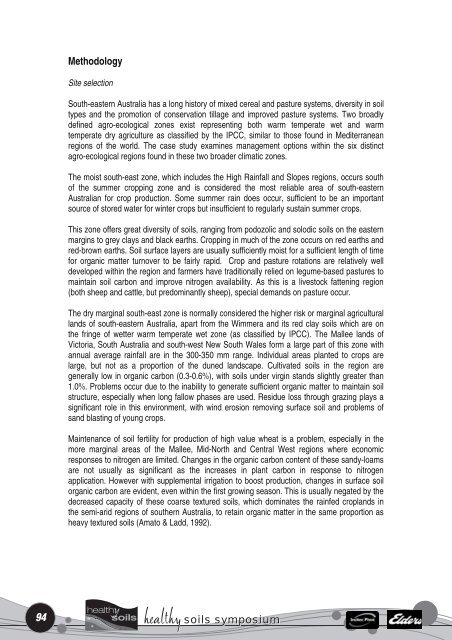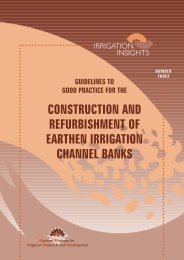The Healthy Soils Symposium Proceedings - Land and Water Australia
The Healthy Soils Symposium Proceedings - Land and Water Australia
The Healthy Soils Symposium Proceedings - Land and Water Australia
Create successful ePaper yourself
Turn your PDF publications into a flip-book with our unique Google optimized e-Paper software.
Methodology<br />
Site selection<br />
South-eastern <strong>Australia</strong> has a long history of mixed cereal <strong>and</strong> pasture systems, diversity in soil<br />
types <strong>and</strong> the promotion of conservation tillage <strong>and</strong> improved pasture systems. Two broadly<br />
defined agro-ecological zones exist representing both warm temperate wet <strong>and</strong> warm<br />
temperate dry agriculture as classified by the IPCC, similar to those found in Mediterranean<br />
regions of the world. <strong>The</strong> case study examines management options within the six distinct<br />
agro-ecological regions found in these two broader climatic zones.<br />
<strong>The</strong> moist south-east zone, which includes the High Rainfall <strong>and</strong> Slopes regions, occurs south<br />
of the summer cropping zone <strong>and</strong> is considered the most reliable area of south-eastern<br />
<strong>Australia</strong>n for crop production. Some summer rain does occur, sufficient to be an important<br />
source of stored water for winter crops but insufficient to regularly sustain summer crops.<br />
This zone offers great diversity of soils, ranging from podozolic <strong>and</strong> solodic soils on the eastern<br />
margins to grey clays <strong>and</strong> black earths. Cropping in much of the zone occurs on red earths <strong>and</strong><br />
red-brown earths. Soil surface layers are usually sufficiently moist for a sufficient length of time<br />
for organic matter turnover to be fairly rapid. Crop <strong>and</strong> pasture rotations are relatively well<br />
developed within the region <strong>and</strong> farmers have traditionally relied on legume-based pastures to<br />
maintain soil carbon <strong>and</strong> improve nitrogen availability. As this is a livestock fattening region<br />
(both sheep <strong>and</strong> cattle, but predominantly sheep), special dem<strong>and</strong>s on pasture occur.<br />
<strong>The</strong> dry marginal south-east zone is normally considered the higher risk or marginal agricultural<br />
l<strong>and</strong>s of south-eastern <strong>Australia</strong>, apart from the Wimmera <strong>and</strong> its red clay soils which are on<br />
the fringe of wetter warm temperate wet zone (as classified by IPCC). <strong>The</strong> Mallee l<strong>and</strong>s of<br />
Victoria, South <strong>Australia</strong> <strong>and</strong> south-west New South Wales form a large part of this zone with<br />
annual average rainfall are in the 300-350 mm range. Individual areas planted to crops are<br />
large, but not as a proportion of the duned l<strong>and</strong>scape. Cultivated soils in the region are<br />
generally low in organic carbon (0.3-0.6%), with soils under virgin st<strong>and</strong>s slightly greater than<br />
1.0%. Problems occur due to the inability to generate sufficient organic matter to maintain soil<br />
structure, especially when long fallow phases are used. Residue loss through grazing plays a<br />
significant role in this environment, with wind erosion removing surface soil <strong>and</strong> problems of<br />
s<strong>and</strong> blasting of young crops.<br />
Maintenance of soil fertility for production of high value wheat is a problem, especially in the<br />
more marginal areas of the Mallee, Mid-North <strong>and</strong> Central West regions where economic<br />
responses to nitrogen are limited. Changes in the organic carbon content of these s<strong>and</strong>y-loams<br />
are not usually as significant as the increases in plant carbon in response to nitrogen<br />
application. However with supplemental irrigation to boost production, changes in surface soil<br />
organic carbon are evident, even within the first growing season. This is usually negated by the<br />
decreased capacity of these coarse textured soils, which dominates the rainfed cropl<strong>and</strong>s in<br />
the semi-arid regions of southern <strong>Australia</strong>, to retain organic matter in the same proportion as<br />
heavy textured soils (Amato & Ladd, 1992).<br />
94<br />
healthy soils symposium

















